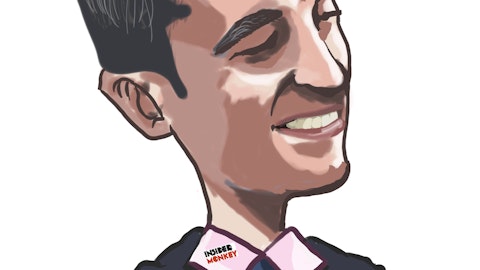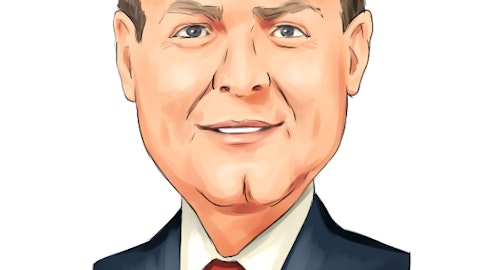Operator: Our next question comes from the line of Chad Bennett with Craig-Hallum. Please proceed with your question.
Chad Bennett: Great. Thanks for taking my questions. Nice job again on the quarter. So just €“ Jason, I don’t think I’ve heard a ton from you or a lot from you on adjacencies in life sciences and high-tech. And I know you pointed out a couple on the call that looked very interesting. Can you talk about, I guess, from a pipeline go-to-market standpoint, how long or how far along we are in really looking or approaching these adjacencies and maybe what the opportunity is for Model N, because I think it’s something that €“ I know you’ve been laser-focused on the core life sciences biz and core semi high-tech biz since you got there, but it seems like something that’s opening up a bit.
Jason Blessing: Yes, it’s a good question, Chad. I appreciate you noticing that as well from the script. I guess there’s a couple of things I would say. I mean, first and foremost, we’re excited about the white space in our customer base in high-tech and life sciences as it exists today. We remain excited about new logos and geographic expansion as it exists in our wheelhouse today. And so we don’t actively today spend a lot on sales and marketing going into adjacencies. But these wins this quarter I talked about, I think, do a nice job of illustrating the art of what’s possible in the future. And I would also characterize the wins that I talked about today as not even a full standard deviation away from the markets we’re in today.
If you look at life sciences and some of the pattern recognition, our products play well in life sciences, where things are heavily regulated and there are complex incentives to distribute and reward the channel for those products. And then on the high-tech side, if it’s a highly engineered product that’s distributed through a multi-tier channel €“ complex multi-tier channel, the high-tech products are a pretty good fit for that pattern. And so these customers that come in, we’re opportunistic about them. And if they fit with the patterns and the situations where we know we can win, we will pursue them, and some of these early returns have been good.
Chad Bennett: Got it. I appreciate it. Maybe one for John. Just in terms of the cadence of SaaS ARR for the rest of the year, should we think about it similar, whether it’s seasonally, sequentially as to last year? And then if you look at it from a net new SaaS ARR standpoint, I mean, you put up a very good net new SaaS ARR quarter in the December quarter. Does net new SaaS ARR grow year-over-year in the next three quarters? Any way you want to address that one? Thanks.
John Ederer: Yes. Thanks, Chad. Maybe I’ll just reiterate a couple of the comments that we made upfront and try to address your question that way. I think that we want to stay just shy of providing very specific guidance on SaaS ARR, but we did want to try and provide some color commentary in terms of how we see the year laying out. And over the last €“ this actually goes back over the last couple of quarters, we’ve seen SaaS ARR growth accelerating as we’ve been benefiting from SaaS transitions in particular. And so the last few quarters, you’ve seen that number tick up, hitting 36% year-over-year growth in Q1. Our long-term target, as you know, is 20%. But as we look at the course of this year, we do expect to be at an elevated level again in Q2, where we also have an easier year-over-year comparison to Q2 of last year.
But then as we get out to Q3 and Q4 of this year, the comparisons do get a little bit tougher for that year-over-year growth number, and so we would expect it to moderate a little bit based on those comparisons over the second half of the year. And then I would just add, similarly, we would expect the SaaS net dollar retention metric to follow the same type of trend. And so we would expect to see that a little bit elevated as it was in Q1 and over the first half of the year and then moderate a little bit over the second half of the year.
Chad Bennett: Got it. And then maybe €“ sorry, one last quick one for you, John. Just on subscription gross margin, how to think about that going forward. It was €“ it’s obviously showed significant year-over-year improvement. I think it was kind of flattish sequentially. Should it kind of stay around this level? Or do you expect to see further improvement there? Then I’ll hop off. Thanks so much.
John Ederer: Yes. No, thanks for the question. So a couple of things there. So first, what we saw in Q1, I would say, largely reflected the increased mix that we’re getting from SaaS revenue. And so when we look at that total subscription line, the SaaS piece of it is at a higher margin, and so an improving mix there helps us. And that was the couple of points that you saw of improvement in Q1 this year versus Q1 last year. One thing I would caution you on over the balance of this year, we do have, of course, headcount-related expenses that hit that line, our cloud hosting team, our support organization. And in Q2, we do have a seasonal uptick in headcount-related expenses for payroll taxes and things like that. And so that will impact that line also. But in general, we’re making good progress and a lot of it has to do with the shift to SaaS.
Chad Bennett: Got it, thank you so much, nice job again.
John Ederer: Yes, Chad.
Operator: Our next question comes from the line of Joe Meares with Truist. Please proceed with your question.
Joe Meares: Hey, guys. Thanks so much for taking the question. I appreciate the color on new logos. And specifically with Lantheus, it was interesting to hear that you landed the State Price Transparency Management as one of the modules they picked up. I’m just curious if you have any qualitative or quantitative comments around attach rates for that product on new logos and how you’re doing there with current customers as well.
Jason Blessing: Yes. Thanks for the question, Joe. So as we’ve reported the last few quarters since we partnered with Pfizer to build and release this product, demand has been strong. And we continue to see new states enacting state price transparency rules. And even more importantly, they’re now stepping up enforcement over the last year, and the forecast is for enforcement to continue to be pretty robust over the next couple of years. So as our existing customers and our new logo pipeline, they’re definitely turning to us and looking at this product. And I would say State Price Transparency Management in new logos is €“ if it’s not a part of every deal, it’s a part of just about every deal. And it’s also garnered a lot of interest as well in our customer base, and we’ve got quite a bit of pipeline tied to the base as well.
So it’s been a good add-on product. It’s been a good wedge product for us to get into new logos. It’s got a fairly easy implementation footprint with it, but it solves a major issue. So yes, State Price Transparency Management has been a good product for us.
Joe Meares: Awesome. Great to hear. I think you’ve talked about Global Price Management and Global Tender Management as potential drivers for growth in 2023. It sounded like you had some success there in the quarter with Solidigm. I’m just curious if these are a material percentage of revenue right now and what they could be exiting this year. Thanks very much for the questions.
Jason Blessing: Yes. Certainly Global Price Management and Global Tender Management are both 50 project €“ products and an important way that we land. Global Price Management as the name implies, is used by our customers to manage their price list in both the U.S. and rest of world and specifically in Europe. So the product market fit for that product is pretty much universal for global pharma companies. And so that is a product that’s quite honestly, it’s been a good seller for us over a number of years now, but that’s not a new product. Global Tender Management is really tailored for geographies where pharmaceutical purchasing processes are run through centralized health ministries through a tendering process. And so Europe is really the first geography that we focused on.
That’s a relatively newer product and demand has been brisk for it because it is tailored again specifically to pharma companies. And as we’ve talked about, we’ve landed some big new logos with that combination, that one-two punch of Global Price Management, Global Tender Management, with Moderna just being the most recent one. So they’re important products in terms of wallet share, and they’re also important products in terms of how we land and then open up the expand opportunity in an account.



